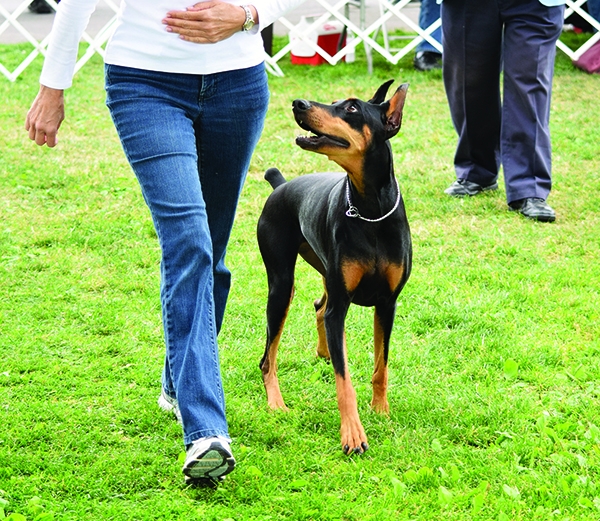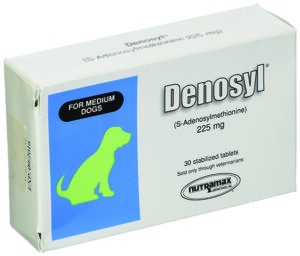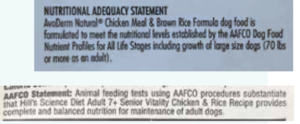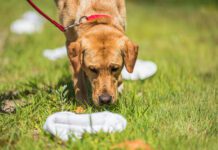
We all know good nutrition is critical for the health and longevity of our dogs, and most of us rely on commercial dog foods to help us achieve that. Now, what if we told you those complete-and-balanced diets – the quality food you’ve carefully chosen for your dog – may be slowly killing him?
It’s true, says Dr. Sharon Center, Emeritus James Law Professor of Internal Medicine at Cornell University’s College of Veterinary Medicine. Dr. Center is nationally renowned for her expertise in liver diseases of dogs and cats. She says the excess amount of the essential trace mineral copper in commercial dog food can cause a serious, potentially lethal, illness called dietary-induced, copper-associated hepatopathy (CAH). The incidence of CAH is increasing at a rate that’s causing alarm among veterinarians and dog owners, with one study showing 30% of canine liver biopsies revealing evidence of CAH.
Certain breeds of dogs are predisposed to CAH, including Bedlington Terriers, Labrador Retrievers, Dalmatians, Dobermans, and Westies – but this is no longer considered a danger to just those breeds. CAH can develop in any dog, and it is expected to happen more and more if copper levels in dog foods remain too high. In fact, it can be actively happening in the liver of a dog showing no outward signs of illness.
ESSENTIAL COPPER IN DOG FOOD
Dietary copper helps your dog make red blood cells and absorb iron. It also functions in the formation of skin and hair pigmentation and connective tissue. A deficiency, though rare, can cause muscular and skeletal problems, so copper is a necessary mineral in our dogs’ food.
Copper-associated hepatopathy in dogs occurs when the amount of dietary copper ingested exceeds their tolerance level and accumulates in the liver. Once in the liver, it can cause acute, severe liver inflammation with immediate, disastrous consequences, or it can cause chronic, insidious damage over time, resulting in widespread scarring of the liver (cirrhosis) and liver failure.
Symptoms of late-stage CAH include abdominal swelling, decreased appetite, diarrhea, increased thirst, jaundice, lethargy, and vomiting. But keep in mind that in the early stages of copper accumulation, there may be no symptoms at all.
“There is certainly a rise in copper-related hepatopathies these days,” says Dr. Joseph J. Wakshlag, Professor of Clinical Nutrition and Sports Medicine and Rehabilitation, and Section Chief of Nutrition at Cornell University’s College of Veterinary Medicine. “It may very well be related to a lack of safe upper limits of copper consumption and higher than expected levels in dog foods,” he says.
Currently, the legal minimum for copper in an adult canine maintenance diet is 7.3 mg/kg (milligrams per kilogram), but that means little to the average consumer because the copper level is rarely listed on dog food labels (you can call your dog-food manufacturer and request it). At this time, however, there is no maximum limit for copper in your dog’s food. At one point, there was, but that was eliminated when the recommended type of copper used in dog foods was changed to a more bioavailable form. Why the limit was eliminated is not clear, but the results most certainly are.
THE EFFECTS OF COPPER IN DOG FOOD

Meet Vira, a happy, seemingly healthy 4-year-old, spayed female Labradoodle. Routine bloodwork performed at her annual wellness exam showed a concerning elevation of alanine transaminase (ALT), a liver enzyme that increases in the presence of liver inflammation or injury. When repeat bloodwork one month later showed an ongoing increase in ALT, Vira underwent liver biopsy surgery. Biopsies confirmed the presence of excessive copper levels in her liver with associated hepatocellular damage or CAH.
Treatment for CAH usually includes administration of an oral copper-chelating agent (a compound that binds to copper to help remove it) called d-penicillamine. Dogs with CAH are also fed a copper-restricted diet to prevent further copper accumulation in the liver. Antioxidants like vitamin E and S-adenosyl-methionine (SAMe) are recommended as supplements.
It can take many months of treatment for the liver damage to resolve. Repeat biopsy is the only definitive way to determine how the affected dog is doing. Because this is an expensive proposition – and most of us don’t want our dogs undergoing multiple invasive surgical procedures – progress is usually monitored with a blood test that measures the liver enzyme ALT. All affected dogs should be fed copper-restricted diets for life, and some dogs will require chronic, low-dose chelation therapy.
Vira has responded favorably to her treatment and her ALT level is now normal. She eats a copper-restricted diet called “The Scoop” (available at safedogfood.com). Other commercial options for copper-restricted diets include Hill’s l/d Liver Care and Royal Canin Hepatic Veterinary Diet (both require a veterinary prescription).
GETTING HELP WITH COPPER-ASSOCIATED HEPATOPATHY

Dr. Wakshlag says that most of the low-copper commercial foods designed for dogs with liver disease are also protein-restricted, which is not appropriate for all CAH cases. “This is where I come in,” says Dr. Wakshlag, who offers nutrition services at the Cornell University Hospital for Animals. Since it’s hard to find commercial diets with low copper and higher levels of protein, a home-prepared diet formulated by a veterinary nutritionist may be the best alternative. “We have been formulating diets for these copper-related hepatopathies in dogs for nearly 20 years,” says Dr. Wakshlag.
It’s also wise, if you have copper water pipes in your home, to flush the lines for several minutes before filling your dog’s water bowl to reduce the copper content in his water.
Electing to have a routine blood chemistry run at Vira’s annual wellness exam most likely saved her life. Please consider this relatively inexpensive option for your dog at his or her annual wellness examination to catch any life-threatening copper toxicity in your dog.
Dr. Center is relentlessly lobbying the FDA to immediately re-establish maximum-allowed copper levels in commercial dog foods and to reconsider current federal canine dietary copper recommendations, but we all need to make our voices heard (see “What You Can Do: Contact the FDA,” below) in order to make this an industry-wide change.

Association of American Feed Control Officials (AAFCO). A non-profit organization consisting of the state officials who are responsible for enforcing state laws regarding the safety of animal feeds. AAFCO provides a forum where state agencies, federal agencies, and industry develop uniform language and model regulations that states may adopt or reference. AAFCO committees have developed protocols for proving the nutritional adequacy of pet foods. In order to be represented as a “complete and balanced diet” for dogs, dog food companies must state on the product label which AAFCO nutritional adequacy protocol the product met; either the product performed adequately in a feeding trial conducted according to AAFCO standards, or it was formulated to meet one of the AAFCO Nutrient Profiles for dogs of a specific life stage. These Nutrient Profiles establish minimum recommended levels – and a few maximum levels – of each essential nutrient for dogs.
National Research Council (NRC). This is the operating arm of the National Academies of Sciences, Engineering, and Medicine (NASEM), a congressionally chartered non-profit organization whose purpose is to provide independent scientific evidence and advice for the benefit of society. Reports from the NRC are used by the FDA to create policies and regulations regarding dog foods, and have helped inform the AAFCO Dog Food Nutrient Profiles, as well.
United States Food and Drug Administration (FDA). A federal agency of the Department of Health and Human Services, responsible for protecting and promoting public health through the control and supervision of many marketed products, including animal foods and feed. The FDA is the only one of these three agencies with the power to change regulations regarding the nutritional content of dog foods.
FOR MORE INFORMATION ON COPPER IN DOG FOOD
The Journal of the American Veterinary Medical Association (JAVMA), recently published a commentary written by a working group comprised of Dr. Center, Dr. Wakshlag, and other veterinary specialists, expressing their concern about the excessive amounts of copper in commercial dog foods; you can read it here.
You can also experience the FDA Virtual Listening Session where Dr. Center discusses CAH and the reasons she is imploring the FDA, NRC, and AAFCO to re-examine dietary copper recommendations, reconsider current guidelines, and establish a safe upper limit to copper amounts in commercial dog foods, by visiting bit.ly/WDJ_DrCenter.
Dr. Center asks that if your dog has been diagnosed with copper hepatopathy, please complete the FDA questionnaire at https://www.fda.gov/animal-veterinary/reportproblem/how-report-pet-food-complaint. Ask your veterinarian to do the same, as entries from veterinarians are taken very seriously. You can start by Selecting “Safety Reporting Portal,” and identify yourself as a guest. Then select, “Start a New Report.”
For a title for your FDA report, Dr. Center recommends “Dog Food Copper Over-Supplementation.” Fill out the form to the best of your ability, trying not to leave any entries blank. The entry marked “Problem Summary” is the most important entry, says Dr. Center. Make it clear to the FDA that your dog was affected by copper overdose through dog food and add personal commentary regarding your experience.
For example, you might say: “My dog was impacted by copper-associated hepatopathy thought to be due to over-supplementation of copper in commercial pet food. I implore the FDA to take corrective action to lower the maximum copper concentration in commercial dog food to mitigate this avoidable and potentially fatal illness.”
We recommend that you expand this entry with your personal commentary of hardship you endured. Tell them about the expenses you incurred, your dog’s illness, the difficulty of the diagnosis and management, and the emotional stress to yourself and your family.
This article originally appeared in Cornell Dogwatch, the official publication of the Cornell Margaret and Richard Riney Canine Health Center. To subscribe, visit www.dogwatchnewsletter.com.






It is not just the quantity of copper in dog foods. It is the type of copper that should be given i.e.
COPPER OXIDE (Natural copper) which the body can expell unlike the artificial copper sulfate and copper chelate etc..
Please see the research done by Michigan State University that can be seen on U tube or The Scoop Dog Food website re Copper Storage Disease. Their compelling research showed an increase in CSD in breeds normally not affected since the replacement of copper oxide with copper sulfate. The replacement of copper sulfate was NOT tested in dogs. Copper Sulfate was used to grow farm animals quicker and heavier for market purposes,
The Scoop Dog Food company contains copper oxide to their dog food. I have not found any other company that produces dog food that use te natural copper.
Hi, Thank you for the information about copper form in dog food. I am using a product called “mealmix” formulated by Dr. Karen Becker, DVM for MercolaHeathyPets. It is a powdered mix of minerals and vitamins that is added to meat and veggies to make balanced, home-made dog food. I just checked and it contains “copper gluconate”. If you have time and know, please comment on the safety of this form of copper. Thanks!
The other foods I feed by Stella and Chewy contain “copper proteinate” a made up term. Any info is appreciated. Thanks
My Jack Russell Terrier suffered from Copper Associated Hepatopathy, which we were fortunately able to diagnose somewhat early. He fared well on d-penicillamine and a copper-restricted diet from Darwin’s Pet Foods, which was a lifesaver when he struggled to get the nourishment he needed.
I appreciate Cornell allowing this article to be shared because I had never heard of this condition, but it leaves out a lot of potentially useful information for the pet parent. For instance, how does a dog food end up with high levels of copper, i.e. what are the factors in ingredient sourcing and processing and what recipes seem to be at issue? What dog foods have the dogs diagnosed with CAH been eating? Surely that data was collected at diagnosis, and if vets in general are alarmed by the incidence of CAH, then they know that answer for the patients they have seen. Countless food manufacturers and brands have been called out over the years for incidents like the melamine contamination scandal in the early 2000’s, the fatal levels of vitamin D in Hills food a few years ago, and bacterial contamination of certain lots of food. Why don’t we deserve to know what foods might be the culprits in the increase in CAH?
Yes, I agree with MKRay. It would be very helpful to know what manufacturers and brands are involved.